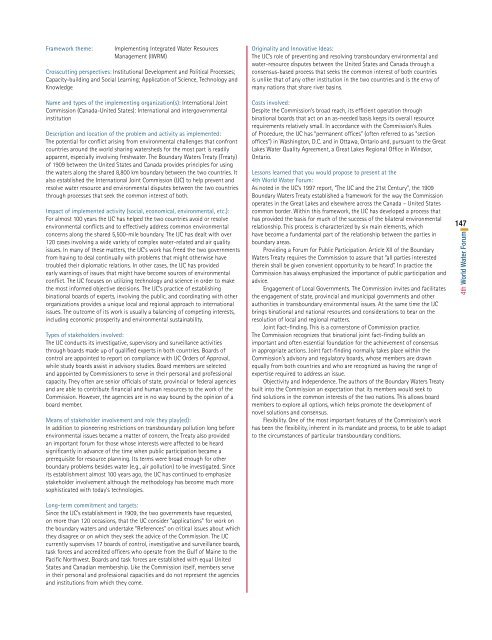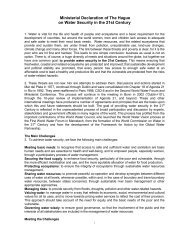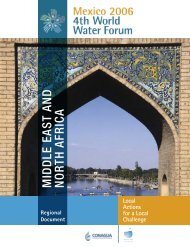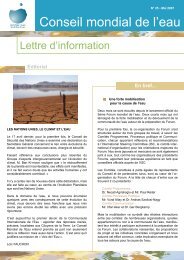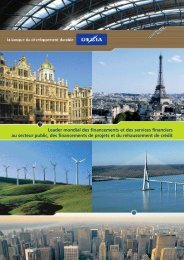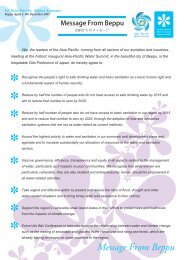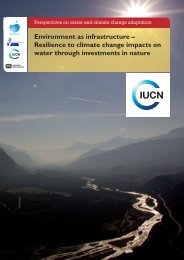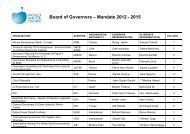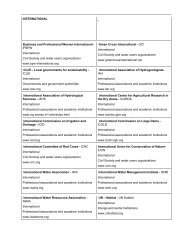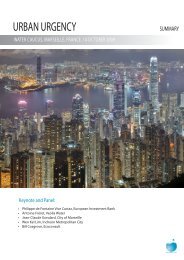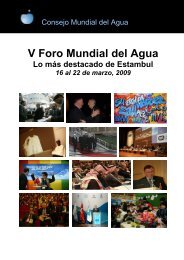Americas ok.indd - World Water Council
Americas ok.indd - World Water Council
Americas ok.indd - World Water Council
You also want an ePaper? Increase the reach of your titles
YUMPU automatically turns print PDFs into web optimized ePapers that Google loves.
Framework theme:Implementing Integrated <strong>Water</strong> ResourcesManagement (IWRM)Crosscutting perspectives: Institutional Development and Political Processes;Capacity-building and Social Learning; Application of Science, Technology andKnowledgeOriginality and Innovative Ideas:The IJC’s role of preventing and resolving transboundary environmental andwater-resource disputes between the United States and Canada through aconsensus-based process that seeks the common interest of both countriesis unlike that of any other institution in the two countries and is the envy ofmany nations that share river basins.Name and types of the implementing organization(s): International JointCommission (Canada-United States): International and intergovernmentalinstitutionDescription and location of the problem and activity as implemented:The potential for conflict arising from environmental challenges that confrontcountries around the world sharing watersheds for the most part is readilyapparent, especially involving freshwater. The Boundary <strong>Water</strong>s Treaty (Treaty)of 1909 between the United States and Canada provides principles for usingthe waters along the shared 8,800 km boundary between the two countries. Italso established the International Joint Commission (IJC) to help prevent andresolve water resource and environmental disputes between the two countriesthrough processes that seek the common interest of both.Impact of implemented activity (social, economical, environmental, etc.):For almost 100 years the IJC has helped the two countries avoid or resolveenvironmental conflicts and to effectively address common environmentalconcerns along the shared 5,500-mile boundary. The IJC has dealt with over120 cases involving a wide variety of complex water-related and air qualityissues. In many of these matters, the IJC’s work has freed the two governmentsfrom having to deal continually with problems that might otherwise havetroubled their diplomatic relations. In other cases, the IJC has providedearly warnings of issues that might have become sources of environmentalconflict. The IJC focuses on utilizing technology and science in order to makethe most informed objective decisions. The IJC’s practice of establishingbinational boards of experts, involving the public, and coordinating with otherorganizations provides a unique local and regional approach to internationalissues. The outcome of its work is usually a balancing of competing interests,including economic prosperity and environmental sustainability.Types of stakeholders involved:The IJC conducts its investigative, supervisory and surveillance activitiesthrough boards made up of qualified experts in both countries. Boards ofcontrol are appointed to report on compliance with IJC Orders of Approval,while study boards assist in advisory studies. Board members are selectedand appointed by Commissioners to serve in their personal and professionalcapacity. They often are senior officials of state, provincial or federal agenciesand are able to contribute financial and human resources to the work of theCommission. However, the agencies are in no way bound by the opinion of aboard member.Means of stakeholder involvement and role they play(ed):In addition to pioneering restrictions on transboundary pollution long beforeenvironmental issues became a matter of concern, the Treaty also providedan important forum for those whose interests were affected to be heardsignificantly in advance of the time when public participation became aprerequisite for resource planning. Its terms were broad enough for otherboundary problems besides water (e.g., air pollution) to be investigated. Sinceits establishment almost 100 years ago, the IJC has continued to emphasizestakeholder involvement although the methodology has become much moresophisticated with today’s technologies.Costs involved:Despite the Commission’s broad reach, its efficient operation throughbinational boards that act on an as-needed basis keeps its overall resourcerequirements relatively small. In accordance with the Commission’s Rulesof Procedure, the IJC has “permanent offices” (often referred to as “sectionoffices”) in Washington, D.C. and in Ottawa, Ontario and, pursuant to the GreatLakes <strong>Water</strong> Quality Agreement, a Great Lakes Regional Office in Windsor,Ontario.Lessons learned that you would propose to present at the4th <strong>World</strong> <strong>Water</strong> Forum:As noted in the IJC’s 1997 report, “The IJC and the 21st Century”, the 1909Boundary <strong>Water</strong>s Treaty established a framework for the way the Commissionoperates in the Great Lakes and elsewhere across the Canada – United Statescommon border. Within this framework, the IJC has developed a process thathas provided the basis for much of the success of the bilateral environmentalrelationship. This process is characterized by six main elements, whichhave become a fundamental part of the relationship between the parties inboundary areas.Providing a Forum for Public Participation. Article XII of the Boundary<strong>Water</strong>s Treaty requires the Commission to assure that “all parties interestedtherein shall be given convenient opportunity to be heard”. In practice theCommission has always emphasized the importance of public participation andadvice.Engagement of Local Governments. The Commission invites and facilitatesthe engagement of state, provincial and municipal governments and otherauthorities in transboundary environmental issues. At the same time the IJCbrings binational and national resources and considerations to bear on theresolution of local and regional matters.Joint Fact-finding. This is a cornerstone of Commission practice.The Commission recognizes that binational joint fact-finding builds animportant and often essential foundation for the achievement of consensusin appropriate actions. Joint fact-finding normally takes place within theCommission’s advisory and regulatory boards, whose members are drawnequally from both countries and who are recognized as having the range ofexpertise required to address an issue.Objectivity and Independence. The authors of the Boundary <strong>Water</strong>s Treatybuilt into the Commission an expectation that its members would seek tofind solutions in the common interests of the two nations. This allows boardmembers to explore all options, which helps promote the development ofnovel solutions and consensus.Flexibility. One of the most important features of the Commission’s workhas been the flexibility, inherent in its mandate and process, to be able to adaptto the circumstances of particular transboundary conditions.1474th <strong>World</strong> <strong>Water</strong> ForumLong-term commitment and targets:Since the IJC’s establishment in 1909, the two governments have requested,on more than 120 occasions, that the IJC consider “applications” for work onthe boundary waters and undertake “References” on critical issues about whichthey disagree or on which they seek the advice of the Commission. The IJCcurrently supervises 17 boards of control, investigative and surveillance boards,task forces and accredited officers who operate from the Gulf of Maine to thePacific Northwest. Boards and task forces are established with equal UnitedStates and Canadian membership. Like the Commission itself, members servein their personal and professional capacities and do not represent the agenciesand institutions from which they come.


